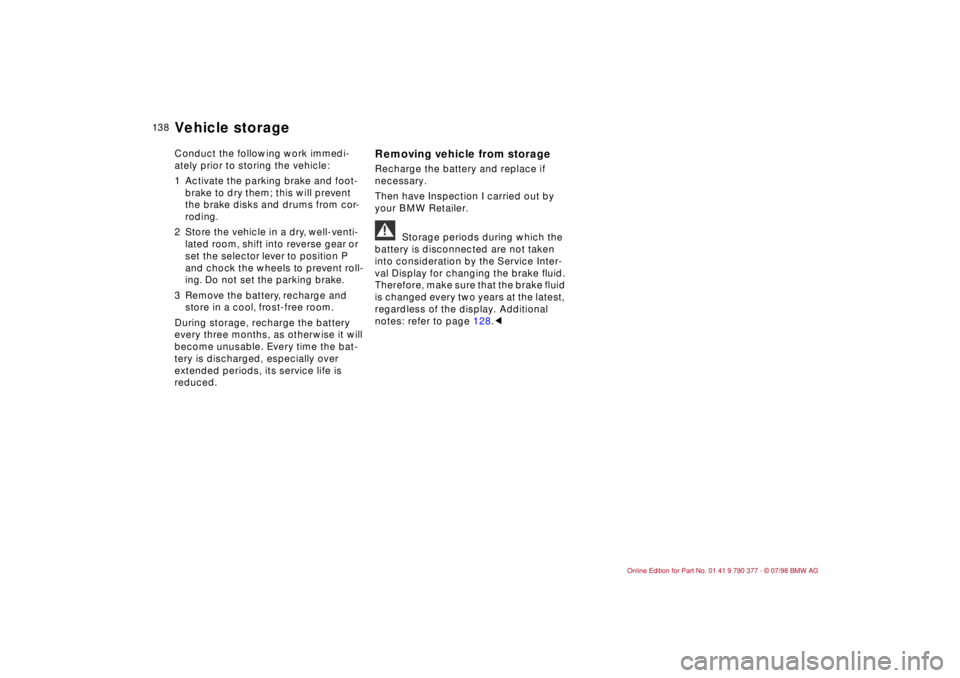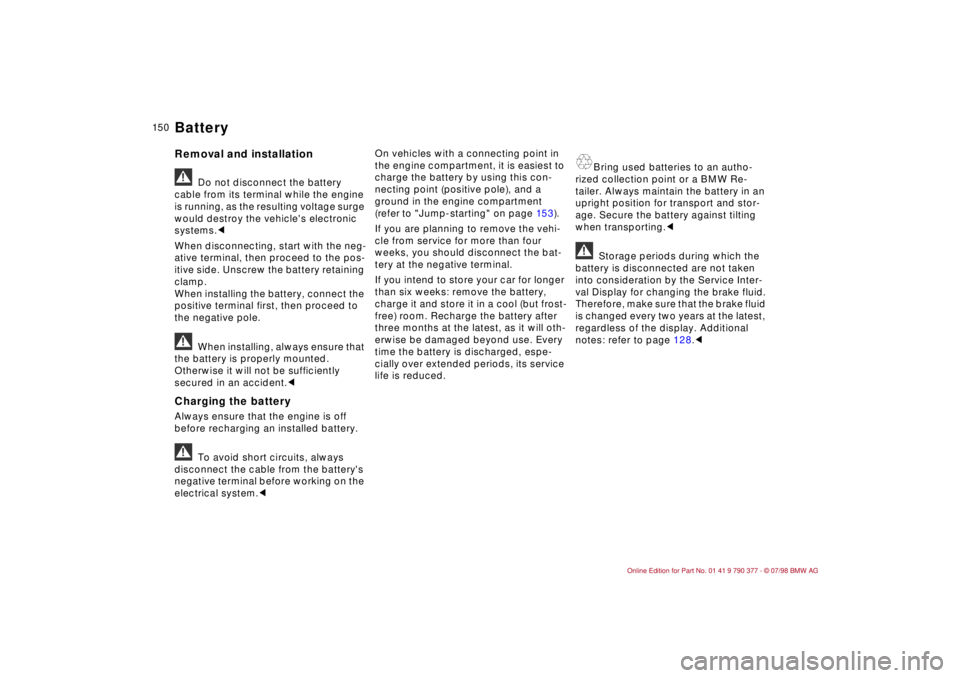Page 134 of 179

13 3
At a glanceControlsCar careRepairsTechnicalDataIndex
Waxing your carProtect the finish using carnauba or
synthetic-based waxes only.
The best way to determine when the
finish needs to be waxed is by noting
when water stops beading on the sur-
face.
You can use a glass cleaner to remove
any wax or silicone that may have been
left on the windows during waxing.b
A full range of car-care products is
available from your BMW Retailer.c
Paint damageYou can touch up small areas of dam-
age with BMW spray paint, a BWM
touch-up stick or BMW paint tape.
The paint color code for your car is pro-
vided on a sticker located next to the
type plate and on the first page of your
Service and Warranty Information book-
let.
Damage caused by flying stones,
scratches, etc. must be touched up
without delay to prevent rust from form-
ing.
If corrosion has started to form in an
area with paint damage, remove all rust
and clean the area, then prime the area
with a BMW Primer Stick. Finally, apply
the finish coat. Wait a few days, then
polish the repaired area. Finish by
applying a wax preservative.
More extensive paint damage should be
professionally repaired in accordance
with the manufacturer's instructions.
Your BMW Retailer uses original BMW
finish materials in accordance with offi-
cial repair procedures.
Caring for other vehicle compo-
nents and materialsLight-alloy wheels
* should be treated
with alloy wheel cleaner, particularly dur-
ing the winter months. Refrain from using
aggressive products containing acids,
strong alkalis or abrasives. Alloy wheels
should not be cleaned with a steam jet
operating at temperatures in excess of
140 5F (606) (note manufacturer's
instructions).
You can use window and glass cleaner to
clean inside window surfaces and mir-
rors without smearing and streaking.
Never use polishing pastes or abrasive
(quartz) cleansers on mirror lenses.
Clean plastic parts, imitation leather sur-
faces, the roof lining, the lenses of lamps,
the glass cover of the instrument panel
and all dull black sprayed parts with
water or products for the care of plastics.
Avoid soaking the headliner. Never use
solvents such as lacquer thinner, heavy-
duty grease remover, fuels, etc.
Rubber components should be cleaned
with water only; a rubber treatment or sil-
icone spray may also be applied.
Clean the wiper blades with soapy water.
The wiper blades should be replaced
twice a year, before and after the cold
season.
Caring for your car
Page 139 of 179

13 8
Conduct the following work immedi-
ately prior to storing the vehicle:
1 Activate the parking brake and foot-
brake to dry them; this will prevent
the brake disks and drums from cor-
roding.
2 Store the vehicle in a dry, well-venti-
lated room, shift into reverse gear or
set the selector lever to position P
and chock the wheels to prevent roll-
ing. Do not set the parking brake.
3 Remove the battery, recharge and
store in a cool, frost-free room.
During storage, recharge the battery
every three months, as otherwise it will
become unusable. Every time the bat-
tery is discharged, especially over
extended periods, its service life is
reduced.
Removing vehicle from storageRecharge the battery and replace if
necessary.
Then have Inspection I carried out by
your BMW Retailer.a
Storage periods during which the
battery is disconnected are not taken
into consideration by the Service Inter-
val Display for changing the brake fluid.
Therefore, make sure that the brake fluid
is changed every two years at the latest,
regardless of the display. Additional
notes: refer to page 128.c
Vehicle storage
Page 140 of 179
At a glance
Controls and featuresCare and maintenanceAdvanced technology
Technical data
Owner service procedure
At a glanceControlsCar careRepairsTechnicalDataIndex
Index
13 9
Replacement procedures:
Onboard tool kit140
Windshield wiper blades140
Lamp and bulbs141
Master key with battery lamp145
Changing tires146
Battery149
Fuses151
In case of electrical
malfunction:
Fuel filler door 152
Sliding/tilt sunroof 152
Assistance, giving and receiving:
Jump-starting153
Towing the vehicle154
Towing154
Page 151 of 179

15 0
Removal and installationa
Do not disconnect the battery
cable from its terminal while the engine
is running, as the resulting voltage surge
would destroy the vehicle's electronic
systems.c
When disconnecting, start with the neg-
ative terminal, then proceed to the pos-
itive side. Unscrew the battery retaining
clamp.
When installing the battery, connect the
positive terminal first, then proceed to
the negative pole.
a
When installing, always ensure that
the battery is properly mounted.
Otherwise it will not be sufficiently
secured in an accident.c
Charging the battery Always ensure that the engine is off
before recharging an installed battery. a
To avoid short circuits, always
disconnect the cable from the battery's
negative terminal before working on the
electrical system.cOn vehicles with a connecting point in
the engine compartment, it is easiest to
charge the battery by using this con-
necting point (positive pole), and a
ground in the engine compartment
(refer to "Jump-starting" on page 15 3).
If you are planning to remove the vehi-
cle from service for more than four
weeks, you should disconnect the bat-
tery at the negative terminal.
If you intend to store your car for longer
than six weeks: remove the battery,
charge it and store it in a cool (but frost-
free) room. Recharge the battery after
three months at the latest, as it will oth-
erwise be damaged beyond use. Every
time the battery is discharged, espe-
cially over extended periods, its service
life is reduced.
A
Bring used batteries to an autho-
rized collection point or a BMW Re-
tailer. Always maintain the battery in an
upright position for transport and stor-
age. Secure the battery against tilting
when transporting.c
a
Storage periods during which the
battery is disconnected are not taken
into consideration by the Service Inter-
val Display for changing the brake fluid.
Therefore, make sure that the brake fluid
is changed every two years at the latest,
regardless of the display. Additional
notes: refer to page 128.c
Battery
Page 156 of 179
At a glance
Controls and featuresCare and maintenanceAdvanced technology
Technical data
Owner service procedure
At a glanceControls Car careRepairsTechnicalDataIndex
Index
15 5
Airbags156
Automatic Stability Control
plus Traction (ASC+T)156
Radio reception157
Safety belt tensioner157
Page 160 of 179
At a glance
Controls and featuresCare and maintenanceAdvanced technology
Technical data
Owner service procedure
At a glanceControls Car careRepairsTechnicalDataIndex
Index
15 9
Engine specifications 160
Dimensions 161
Weights 163
Capacities 166
Electrical system 167
Drive belts 167
Page 170 of 179
At a glance
Controls and featuresCare and maintenanceAdvanced technology
Technical data
Owner service procedure
At a glanceControls Car careRepairsTechnicalDataIndex
Index
169
Everything from A to Z170
Owner service procedures
from A to Z175
Page 173 of 179

172
Note: This index does not correspond to the original manual in all details
IIce warning
66
Identification mark, tires
113
Ignition
54
Ignition key
30
Ignition switch 54
Independent ventilation
81
Indicator lights
20
Inflation pressure 25
, 111
Inside mirror
46
Inside rearview mirror
46
INSPECTION
64
Installing child seats
49
Instrument
18
Instrument lighting
85
Interior lights
86
, 144
Interior lights,
Replace bulbs 144
Intermittent wiper switch
61
JJack
146
Jump start
153
KKeys
30
Kickdown
59
LLeather care
135
LED Light-emitting diodes
110
Length
161
License plate light,
Replace bulb
144Light switch
85
Light-emitting diode LED
110
Limit
80
Loading 98
Lock buttons
31
Locks, care 105
Lowbeam headlight
85
Lowbeam headlights,
Replace lights
141
Low-fuel warning light
64
Luggage straps
34
Lumbar support 45
MM+S-Tires
114
Maintenance 64
, 130
Make-up mirror
46
Manual transmission
57
Capacity
166
Manually controlled
recirculated-air
91
Maximum speed 163
Micro-filter
92
MID Multi-information
display
66
, 67
, 68
, 69
Mirror heating
46
Mirrors
46
Multifunction switch
60
Multi-information display
MID
66
, 67
, 68
, 69
OOdometer
63
OilCapacity
166
Oil additives 125
Oil change interval,
Refer to the service
booklet
124
Oil consumption
124
Oil dipstick
124
Oil filter change
166
Oil filter renewal 166
Oil level, indicator light
20
Oil pressure, indicator light
20
OIL SERVICE
64
Oil, power steering
128
On-board computer 77
, 78
,
79
, 80
, 81
, 82
, 83
Operating
31
Outside rearview mirror
46
Outside temperature
66
, 78
Display
66
Outside temperature
indicator 68
PPaintwork, care
132
Paintwork, dirt and
contaminants 132
Paintwork, minor repairs
133
Paintwork, waxing
133
Parking brake
56
Parking light 85
Parking light,
Replace bulb 141Parking lights
60
Parking, Winter 106
Passenger airbag 50
Payload, maximum 163
Pocket light
93
Power door locks
31
Power steering, oil 128
Pressure, tire
25
Pressure, tires 111
Procedure
147
RRadiator
166
Reading lights
86
Rear backrest,
folding
95
Rear foglight
86
, 143
Reclining seat
43
Refueling
23
Remote control
On-board computer
83
Remove mist
Windshields
91
Replacement keys
30
Reverse
57
Rims
113
, 115
Road performance
163
Roof load, approved 163
Roof load, permissible 163
Roof rack
107
Roof-mounted luggage rack
107
Rubber parts
105
Rubber seals and
Everything from A to Z